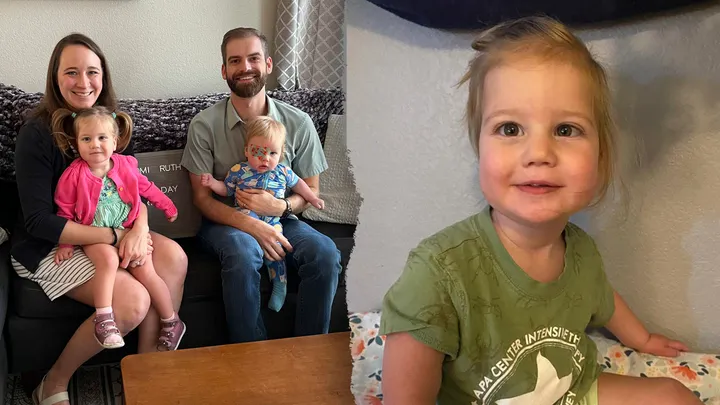Imagine holding your newborn child, filled with hope and dreams for their future, only to be told a few months later that those dreams will never be realized. That your child has a rare, incurable disease that will progressively strip away their ability to move, talk, and eventually, to live. This was the harrowing reality Terry Pirovolakis, an IT director from Toronto, faced when his son Michael was diagnosed with spastic paraplegia 50 (SPG50), a condition so rare that fewer than 100 people worldwide have it. The prognosis was dire: paralysis by age 10, quadriplegia by 20, and a life expectancy that wouldn’t stretch much beyond that.
Most parents would crumble under the weight of such news. But not Terry. Instead of surrendering to despair, he embarked on a journey that would change the course of his son’s life and possibly the lives of other children suffering from SPG50. This is a story of unrelenting determination, the kind that defies the odds and takes on a medical system not designed for rare diseases like SPG50.
A Diagnosis That Changed Everything
Michael’s birth in December 2017 seemed normal. But within six months, Terry and his wife Georgia noticed that something wasn’t right. Michael wasn’t lifting his head, wasn’t meeting the milestones that parents eagerly watch for in their infants. What followed was an 18-month odyssey through the medical system, filled with doctor visits, genetic tests, and mounting fear. Finally, a neurologist gave them the diagnosis: SPG50, a rare neurological disorder that affects a child’s development, leading to muscle weakness, speech impairment, cognitive decline, and eventually paralysis.
The doctors told them to take Michael home and love him, essentially resigning them to the inevitability of his decline. But for Terry, that wasn’t an option. He couldn’t accept that his son’s life was already written off, especially when Michael was still so full of life, so present in the world. “They said he would be paralyzed from the waist down by age 10, and quadriplegic by age 20,” Terry recalled in an interview. “They said he’d never walk or talk, and would need support for the rest of his life.” It was a crushing blow, but it also lit a fire in Terry.
From Desperation to Determination
With no treatment available, Terry decided to take matters into his own hands. He began researching relentlessly, diving into the complexities of gene therapy—an area he knew nothing about but quickly learned was his son’s best hope. The more he learned, the more he realized that the science existed to help Michael. The problem was that no one was developing it, largely because there was no financial incentive to do so. SPG50 affects so few people that it simply wasn’t a priority for pharmaceutical companies.
In March 2019, just a month after Michael’s diagnosis, Terry flew to Washington, D.C., to attend a gene therapy conference. There, he connected with experts and researchers who could help him on this seemingly impossible mission. He also visited research centers in England and the National Institutes of Health at the University of Cambridge, where scientists were studying SPG50. These trips weren’t just about gathering information; they were about building a network of people who could help him develop a treatment for Michael.

Terry and Georgia liquidated their life savings, refinanced their home, and used the money to fund the creation of a proof-of-concept for a gene therapy that could target SPG50. They partnered with a team at the University of Texas Southwestern Medical Center, which succeeded in developing a therapy that showed promise in lab tests—halting the disease’s progression in mice and in human cells.
A Groundbreaking Treatment
After the success in the lab, Terry’s next challenge was to get the drug manufactured and approved for human use. He partnered with a small drug company in Spain to produce the therapy and worked tirelessly to navigate the complex regulatory landscape. Finally, in December 2021, Health Canada approved the gene therapy for use in Michael. On March 24, 2022, Michael became the first person ever to receive this groundbreaking treatment.
The procedure was risky, involving the injection of the gene therapy into Michael’s cerebrospinal fluid via a lumbar puncture. But for the Pirovolakis family, the potential benefits far outweighed the risks. This was their chance to stop SPG50 in its tracks, to give Michael a future that wasn’t defined by a degenerative disease. “When I heard that no one was going to do anything about it, I had to—I couldn’t let them die,” Terry said.
The Struggle to Help Others
The story could have ended there, with Michael receiving the treatment and the Pirovolakis family finally getting a reprieve from their nightmare. But Terry knew that there were other children out there, just like Michael, who needed this therapy. And so, he made it his mission to help them too.
There were three more doses of the drug left after Michael’s treatment, and Terry decided to open a Phase 2 study in the U.S. to treat other children with SPG50. One of those children was 6-month-old Jack Lockard, the youngest to ever receive the therapy. Jack’s mother, Rebekah Lockard, told Fox News that since the treatment, Jack has made incredible progress. “Jack has thrived since then. He is sitting independently, banging toys together, drinking from a straw cup, and working really hard on crawling,” she said. Doctors and therapists alike agree: the treatment works.
But there’s a catch—a big one. The treatment is prohibitively expensive. It costs about $1 million to manufacture the drug for each child, and another $300,000 or so to administer it in a hospital in the U.S. Terry has approached pharmaceutical companies for help, but they’ve all turned him down. “No investor is going to give you money to treat a disease that is not going to make money,” he said. It’s a harsh reality, but one that’s all too common in the world of rare diseases.
The Financial Strain
Without backing from big pharma, the financial burden falls on the families. Terry’s nonprofit, Elpida Therapeutics (Elpida means “hope” in Greek), is working to raise the necessary funds to move forward with a Phase 3 clinical trial at the National Institutes of Health (NIH) this November. The goal is to treat eight children with SPG50 and gather enough evidence to convince the FDA to approve the therapy for broader use. If they succeed, the treatment could be added to newborn screening programs, ensuring that every child diagnosed with SPG50 can receive it.
But the financial strain is immense. Terry’s nonprofit has only five employees and 20 consultants, all working tirelessly to secure grants and investors. Meanwhile, families like the Lockards are turning to crowdfunding to try to raise the hundreds of thousands of dollars needed to treat their children. Rebekah Lockard has raised more than $90,000 through a GoFundMe campaign called “Naomi and Jack Battle SPG50,” but that’s only a fraction of what is needed.
A Race Against Time
Time is running out for these children. SPG50 is a progressive disease, meaning that the longer they wait, the worse the symptoms become. The therapy is sitting in a refrigerator, ready to be administered, but without the funds, it’s just out of reach. There are currently four families in the U.S. who are trying to raise the money needed to treat their children, but they’re fighting against time and a system that isn’t designed to support them.
Terry receives several calls each week from families around the world, desperate for help. It’s heartbreaking because he knows the therapy exists—it’s already saved his son’s life—but without the financial resources, there’s little he can do. “The technology to cure our children is already here,” Terry said. “I hope that someone with immense wealth—and more importantly, the vision and influence—will step in. Their support could not only impact a handful of diseases and children but extend hope to thousands of rare diseases and millions of children, both this generation and the next.”
Looking Ahead
Terry’s story is a powerful testament to the lengths a parent will go to save their child. It’s also a sobering reminder of the gaps in our healthcare system, where the potential for life-saving treatments can be overshadowed by financial realities. But if there’s one thing Terry’s journey has shown, it’s that where there’s love, determination, and a refusal to give up, there’s always hope.
As Elpida Therapeutics prepares for its Phase 3 clinical trial, the stakes couldn’t be higher. If they succeed, the therapy could become widely available, changing the lives of children with SPG50 forever. If they fail, it won’t be for lack of trying. Terry has already moved mountains to get this far, and his determination shows no signs of wavering.
In a world where rare diseases often go overlooked, Terry Pirovolakis is making sure that SPG50 won’t be one of them. He’s fighting not just for his son, but for every child who’s been handed a diagnosis with no options. And in doing so, he’s showing the world that sometimes, it only takes one determined parent to make a difference(Fox News,The New York Sun,OrNs Health News).

